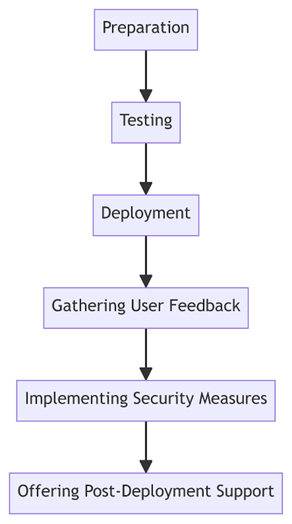Navigating the world of software? Let’s dive into the deployment phase. This is where your software gets ready to meet the real world. In simple terms, think of it like launching a new product in a store.
What’s the Deployment Phase Anyway?
Imagine you’ve built a new app. The deployment phase is when you make sure it’s set up and ready for people to use on their devices. It’s like the grand opening of your app to the public. Sometimes, this can be a manual step where someone actually pushes a button to release the app, or it can be automated, where systems and tools do the heavy lifting, like sending out updates.
Software Release vs. Deployment: Know the Difference
These two terms often get mixed up. Here’s a simple way to think about it:
- Software Release: This is when you have a new version of your app ready. It’s like having a new model of a product. This new model might have new features or fixes to old problems.
- Software Deployment: This is taking that new model and putting it on the store shelves, making sure it works well there, and is ready for customers.
Breaking Down the Deployment Process
Every company might have its own way of doing things, but generally, it comes down to:
- Preparation: Gather all the things you need to deploy the app, like codes and files.
- Testing: Before letting the public use the new version, you test it out. It’s like a trial run to catch any issues.
- Deployment: Once you’re sure everything’s good, you go ahead and launch it for everyone to use.
Why Deployment is a Big Deal
Getting your software out in the world smoothly is crucial. Here’s why:
- Saves Time: Automated tools can get your software out there faster without waiting around.
- Efficiency Boost: Integrated tools and tailored software can make things run smoother.
- Data Management: Handle large amounts of data easily.
- Better Security: A planned deployment is safer than just putting it out haphazardly.
Different Ways to Deploy
There are several methods to deploy your software. Some popular ones are:
- Basic Deployment: Everyone gets the update at once. Quick but can be risky.
- Rolling Deployment: A gradual update, bit by bit. No interruptions but takes longer.
- Blue/Green Deployment: Two versions (old and new) run side by side. Switch when ready.
- Canary Deployment: Some users get the new version first, then slowly everyone gets it. Safe but can be slow.
Best Tips for Smooth Deployment
- Checklist: Always good to have a list to make sure you don’t miss any steps.
- Continuous Delivery: Make changes fast before deploying.
- Track Your Success: Measure how well your deployment is doing.
- Keep Things Separate: Have different areas for testing and the real deal.
Making the Most of Deployment Strategies
Choosing the right deployment strategy can make all the difference. Let’s delve deeper into a few more strategies:
- A/B Testing: This is like a taste test. You give a small group of users a new feature and see how they react compared to users without the feature. This way, you can decide which version is better before rolling it out to everyone.
- Shadow Deployment: Imagine running two versions of your software behind the scenes. Your users only see one, but you send data to both. It’s a sneaky way to test a new version without anyone knowing.
Essential Steps for a Successful Deployment
No matter which strategy you choose, follow these steps for a smooth deployment:
- Backup First: Always have a backup of your current software. If something goes wrong, you can switch back.
- Stay Informed: Keep everyone in the loop. Whether it’s your team or your users, let them know about the deployment and any potential downtime.
- Monitor Religiously: After deployment, keep a close eye on how things are going. If issues pop up, you’ll be ready to tackle them.
- Feedback Loop: Always collect feedback. Users might spot issues or have suggestions that you didn’t think of.
The Perks of Getting Deployment Right
When done right, a successful deployment can:
- Boost User Satisfaction: Users love seamless updates without glitches.
- Reduce Costs: Fewer errors mean less money spent on fixes and damage control.
- Enhance Reputation: Consistently smooth deployments can enhance your brand’s reputation in the market.
The Role of Automation in Deployment
In today’s fast-paced tech environment, automation plays a pivotal role in streamlining the deployment process. Here’s why:
- Consistency: Automated processes ensure that the deployment is consistent every time, reducing human errors.
- Speed: Automation can significantly speed up deployment, ensuring that new features and fixes reach users quickly.
- Resource Management: Less manual intervention means your team can focus on more important tasks, such as developing new features or improving existing ones.
Challenges in Deployment and How to Overcome Them
Despite best efforts, challenges can arise during deployment. Some common hurdles include:
- Compatibility Issues: Sometimes, new software versions might not be compatible with certain devices or operating systems. It’s crucial to test the software on various platforms to ensure wide compatibility.
- Unforeseen Bugs: Even after rigorous testing, some bugs might only appear in real-world scenarios. Having a robust feedback system can help identify and rectify these issues promptly.
- Downtime: Deployments might require some downtime, which can disrupt user experience. Proper communication and scheduling deployments during off-peak hours can mitigate this.
The Importance of Continuous Integration and Continuous Deployment (CI/CD)
CI/CD is a modern approach that emphasizes regular software updates. Here’s how it can benefit deployment:
- Regular Updates: With CI/CD, software updates are frequent, ensuring users always have access to the latest features and fixes.
- Rapid Feedback: Continuous deployment allows developers to receive immediate feedback, helping them make quick adjustments if needed.
- Reduced Risks: Regular, smaller updates mean fewer changes at once, reducing potential risks compared to massive, infrequent updates.
User-Centric Deployment: The Key to Success
As we steer into the future of software deployment, a user-centric approach is becoming increasingly essential. After all, at the heart of every software lies its end-users. Here’s why focusing on users can redefine your deployment success:
- User Feedback: Actively seeking and incorporating feedback ensures that the software meets real-world needs. Users can provide insights that might be overlooked internally.
- Adaptive UI/UX: A software’s user interface and experience should evolve based on user behavior and preferences. Regularly updating and refining the UI/UX can significantly enhance user satisfaction.
- Performance Optimization: Users appreciate a smooth and swift software experience. Continual performance checks and optimizations ensure that the software remains responsive and efficient.
Embracing Cloud-Based Deployment
The cloud is no longer just a buzzword; it’s a paradigm shift in how software is deployed:
- Scalability: Cloud platforms allow for easy scaling, ensuring that as your user base grows, your software can handle the increased load without hiccups.
- Cost-Effective: With cloud deployment, you only pay for what you use, leading to cost savings. No need for hefty investments in physical infrastructure.
- Global Reach: Deploying on the cloud ensures that your software is accessible globally, providing a consistent experience for users across different regions.
Continuous Learning and Upgradation
The tech world is ever-evolving. To stay ahead:
- Stay Updated: Regularly update your team’s skills through workshops, courses, and certifications.
- Embrace New Technologies: Don’t shy away from integrating new tools and technologies that can enhance your deployment process.
- Collaborate and Network: Engaging with the broader tech community can provide fresh perspectives and insights into best practices.
Keeping Security at the Forefront
In an era where data breaches are becoming increasingly common, ensuring the security of your software during the deployment phase cannot be overstated.
- Regular Audits: Conducting security audits before deployment can pinpoint potential vulnerabilities. Addressing these beforehand can save a lot of hassle in the long run.
- Encryption: Ensure data, both at rest and in transit, is encrypted. This adds an extra layer of protection, making unauthorized access significantly more challenging.
- Access Control: Limit access to your deployment environment. Only personnel who absolutely need access should have it, reducing the risk of internal breaches.
The Role of DevOps in Streamlining Deployment
DevOps, a blend of Development and Operations, is revolutionizing the deployment process:
- Collaboration: DevOps encourages developers and operations teams to collaborate closely, ensuring that software is not only functional but also deployable and maintainable.
- Automation: DevOps heavily emphasizes automation, ensuring that repetitive tasks are handled swiftly, reducing the margin for human error.
- Feedback Loops: Continuous feedback between operations and developers can help in quickly identifying and addressing issues, leading to a more resilient software.
Sustainability in Deployment
As we become more environmentally conscious, sustainable deployment practices are gaining traction:
- Energy Efficiency: Opt for hosting providers that use renewable energy sources, reducing the carbon footprint of your software.
- Optimized Code: Efficiently written code requires less computational power, resulting in lower energy consumption.
- Waste Reduction: Digital waste is a concern. Regularly cleaning databases, removing outdated libraries, and optimizing storage can lead to more sustainable software operations.
Integrating User Experience (UX) in Deployment
The success of any software isn’t just about its functionality but also how users perceive it. Enhancing the user experience can significantly impact deployment success:
- User Testing: Before deployment, getting real users to test the software can provide invaluable feedback. Their firsthand experience can highlight areas for improvement.
- Responsive Design: Ensure your software looks and works well across devices. Whether someone’s on a desktop, tablet, or mobile, they should have a seamless experience.
- Intuitive Navigation: A clear, easy-to-navigate interface can make users feel at home, reducing the learning curve and enhancing user satisfaction.
The Importance of Post-Deployment Support
Once the software is deployed, the journey isn’t over:
- User Support: Providing robust support, be it through helplines, chatbots, or FAQs, ensures users have a go-to when they face issues.
- Regular Updates: Post-deployment, regularly roll out updates to address any bugs, improve performance, and introduce new features.
- Feedback Mechanism: Encourage users to provide feedback. It’s a goldmine of insights that can guide future enhancements and deployments.
Preparation” to “Offering Post-Deployment Support”

Embracing Diversity in Deployment
In today’s globalized world, software often caters to a diverse audience:
- Localization: Tailor your software to cater to local languages, customs, and preferences. This personal touch can enhance user engagement.
- Accessibility: Ensure your software is accessible to everyone, including those with disabilities. Features like screen readers, voice commands, and easy-to-read fonts can make a world of difference.
Concluding Thoughts: Deployment as a Continuous Cycle
Software deployment isn’t a one-off event. It’s a continuous cycle of improvement, feedback, and adaptation. As technologies evolve and user preferences shift, deployment strategies must be revisited and refined. By maintaining a user-centric approach, prioritizing security, and being receptive to feedback, businesses can ensure that their deployment strategies remain relevant and effective. In the dynamic world of software, adaptability and foresight are the keys to sustained success.
Innovate Intelligently by connecting with these expert Software Developers.
Table of Contents
Toggle






